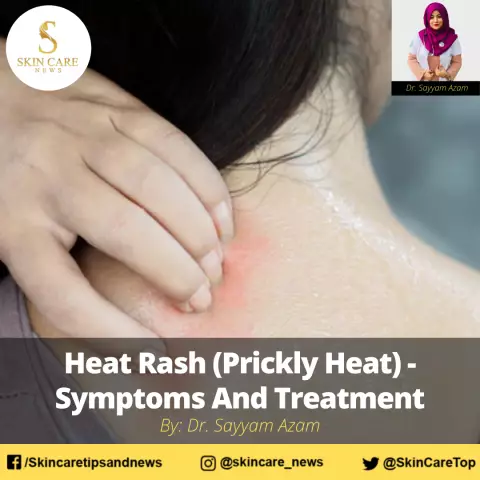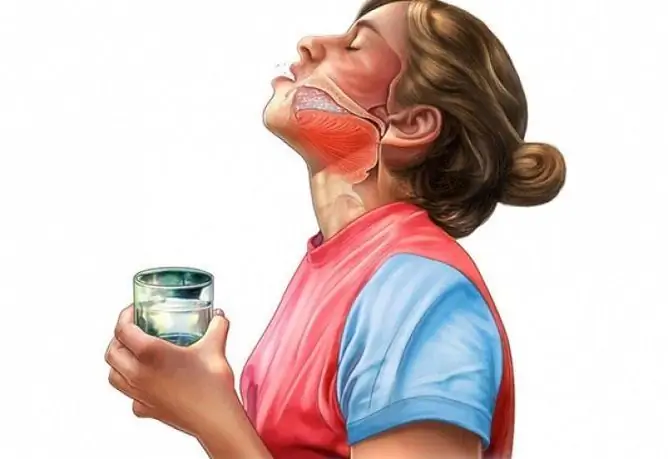- Author Rachel Wainwright [email protected].
- Public 2023-12-15 07:39.
- Last modified 2025-11-02 20:14.
Prickly heat
Brief description of the disease

Our story about prickly heat begins with the fact that we list only a small part of its "popular" names. Prickly heat, heat lichen, heat prickly heat, simply prickly heat - all these definitions refer to the same skin disease. Miliaria in children and adults is characterized by the appearance of redness and rash, which are formed as a result of intense sweating, slow evaporation of moisture and, as a result, clogging of the sweat glands. In some cases, instead of a rash, patients develop small blisters filled with transparent contents. The disease affects the delicate skin of children, but if adverse conditions coincide, prickly heat may appear in adults.
The main provoking factor of the disease is overheating of the body and increased sweating. So, for example, the now widespread prickly heat in newborns occurs due to too much wrapping of the baby or the use of synthetic clothing, which disrupts the normal gas exchange of the skin. In children, a rash appears much more often, since the skin of the baby is still imperfect and cannot resist aggressive environmental factors. We also note that prickly heat, the treatment of which is usually carried out at home, is not contagious and absolutely safe. However, if a rash develops, we advise you to see a doctor immediately, as the unpleasant itching in the affected areas is a concern for both the baby and the mother.
Most often, prickly heat in children occurs on the neck, elbow folds, back and groin folds, that is, in "weakly ventilated" places. It is these areas of the skin that you should pay special attention to when choosing clothes and preventive measures.
Prickly heat - treatment of the disease

If prickly heat is observed in adults, treatment is based on strict adherence to body hygiene and taking vitamins, as well as desensitizing and antihistamines. In the case of infants, everything is somewhat more complicated, since standard medications are not suitable for them. For this reason, prickly heat in newborns is treated with disinfectant solutions. Currently used: 1-2% alcohol solution of salicylic acid, alcoholic solution of boric acid and 0.1% solution of potassium permanganate. To relieve itching, you can treat the lesion focus with antiseptic agents, which include: fucorcin, 1% alcohol solution of chlorophyllipt and 1% methylene blue solution.
In the event that a doctor detects prickly heat in children, treatment is also based on regular baths with decoctions of medicinal herbs. For them, you should use only fresh decoctions of a string, arnica, yarrow and chamomile. Old herbs will not work because they do not have the necessary healing power.
If all the above procedures are followed, prickly heat in children disappears after 2-3 days. Very rarely, the disease gives a complication in the form of the appearance of small bubbles at the site of the rash. If such symptoms appear, self-medication should be discontinued and a specialist should be consulted. He will determine the cause of the complications and prescribe adequate treatment. In severe forms of the disease, the baby may be prescribed antihistamines.
Prevention of the disease
In order for prickly heat in adults and children never to make itself felt, it is necessary to adhere to a few simple but effective rules:
- In order for prickly heat in adults and children never to make itself felt, it is necessary to adhere to a few simple but effective rules:
- do not wrap your child up unnecessarily, or at least wear clothes that can be removed if it gets warm, for example, two light blouses instead of one thick one;
- so that prickly heat, the treatment of which gives the child certain inconveniences, does not become a reality - buy clothes made from natural fabrics that provide natural gas exchange of the skin;
- if you lubricate the baby's skin with cream, then for the summer, choose a lighter and quickly absorbing composition;
- in the first six months of a child's life, you should bathe every day. The same goes for the summer months when the skin sweats much more intensely;
- prickly heat in newborns often appears as a result of exposure to direct sunlight and drafts. Their influence must be completely eliminated. To do this, give your baby air baths more often and do not forget to close the windows in cold weather.
If preventive measures did not help, and prickly heat appeared in children, treatment is aimed at relieving itching and other unpleasant symptoms, since the child begins to scratch the skin, which increases the duration and severity of the disease. As a means of first aid, you can use water-soda compresses (1 teaspoon of soda in a glass of water), which are applied to the damaged areas for 10-15 minutes several times a day.
YouTube video related to the article:
The information is generalized and provided for informational purposes only. At the first sign of illness, see your doctor. Self-medication is hazardous to health!






